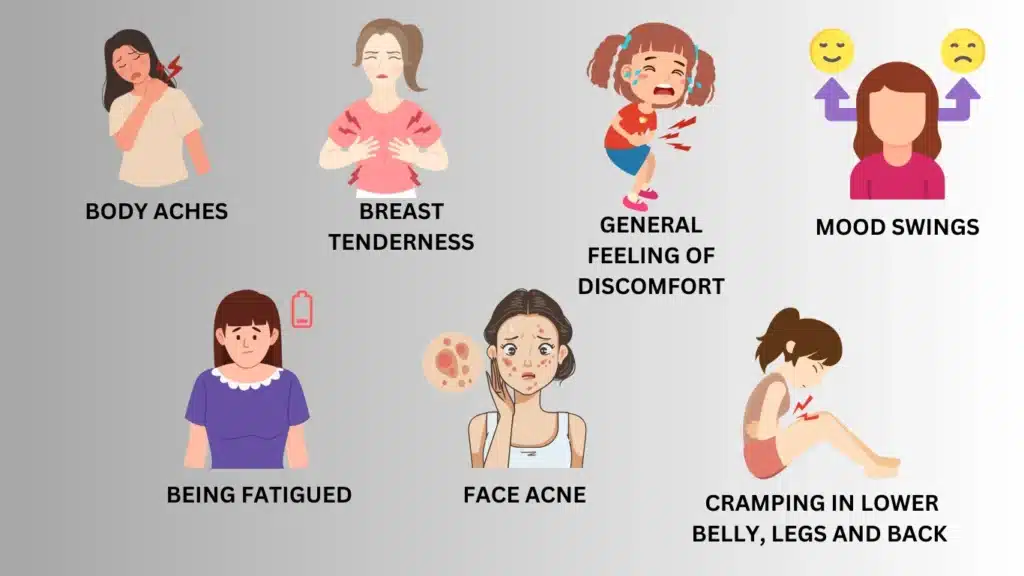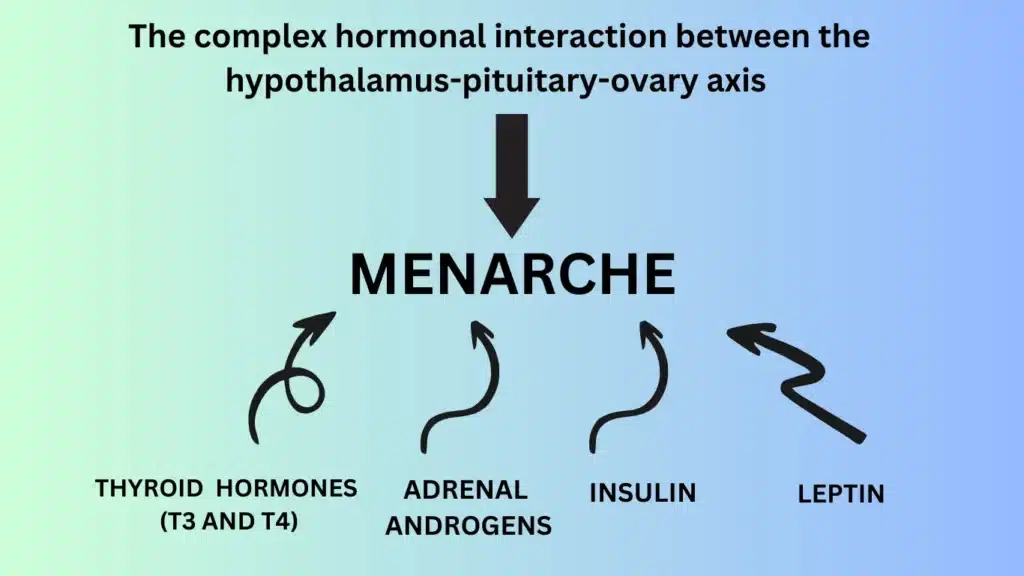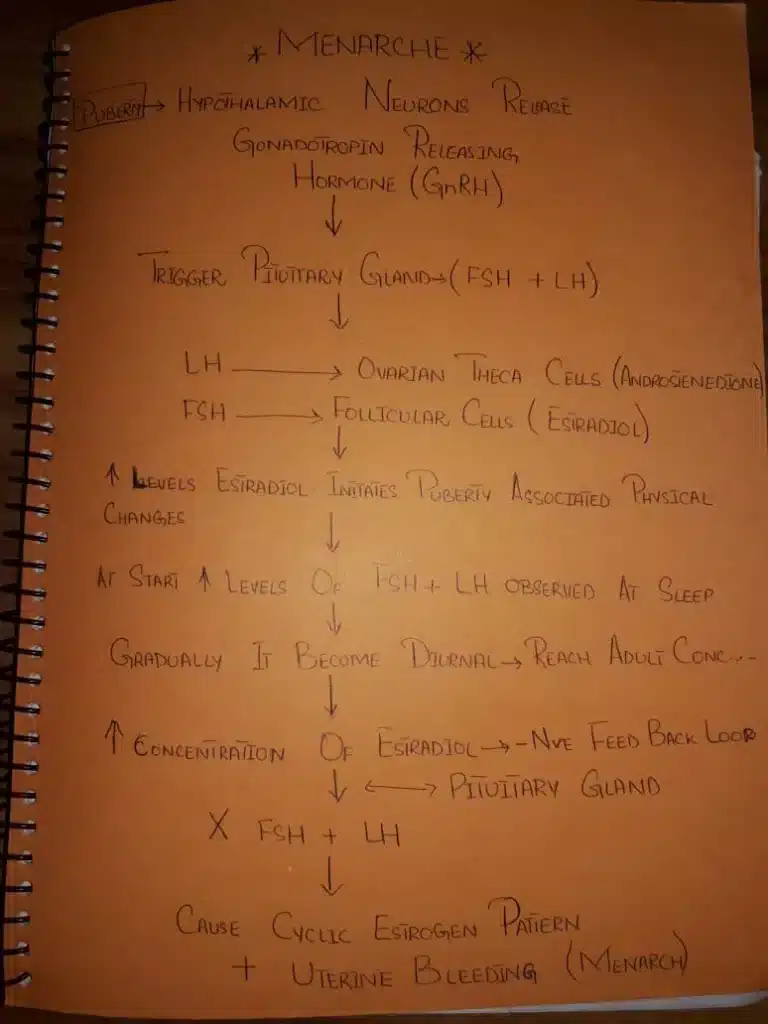Overview:
Menarche can be defined as an essential life event for a girl to have her first menstruation. It is the time when an adolescent female experiences the monthly cycle. More specifically, we call it the monthly period. Menarche is a significant milestone that determines the initiation of the reproductive journey.
It is considered an essential event in the life of the adolescent girl. Different civilizations in the world have different perspectives on Menarche. If we are talking about the West, it is taken as a normal phenomenon. At the same time, in many Asian countries, Menarche is known to be a transitional phase toward womanhood, that is why girls facing Menarche were separated from boys-associated activities either on the ground or in schools.
Menarche vs Menstruation:
Menarche and menstruation are two different things. Menarche is the start of the menstrual cycle. A girl who experiences her first menstrual cycle is said to be Menarche. The body undergoes various changes before the onset of it, including:
- Breast budding.
- Wider pelvic bone.
- Acne and oily skin.
- Hair distribution on the entire body, including pubic and armpit hairs.
- Deep voice, etc.
Menstruation is one of the phases of the menstrual cycle, in which, under hormonal influence, the uterine wall is shedded (which is formed in other phases of the menstrual cycle for implantation of a possible fertilized egg) along with associated blood capillaries resulting in bleeding. This process happens in cases when pregnancy does not occur.
Age criteria for Menarche:
The age limit for the first menstrual period is 10 to 15, and the average is 12.3 years. The age criteria are different for all the regions of the world. According to the latest research, it is suggested that brown-skin females experience their initial periods three months earlier than white-skin females. This variation reflects the genetic relation having elevated insulin responses towards glucose challenges and enhances free IGF-1, linked with skeletal and sexual maturation. Various other factors, such as socioeconomic condition, overall health, nutritional profile, exercise, and family status, contribute, but the topic is still under research.
In Asian countries, the age limit for Menarche is earlier than in the West. Still, getting Menarche at the same age as her mother is possible. There are various causative factors associated with delayed menarche, including family history, economic status, overall mental and physical health of the body, etc.
Signs and symptoms:

Mostly, Menarche is painless and occurs with no warning. The cycle is without ovulation and has a variable flow and length. As it is a unique experience for the body, it shows some symptoms associated with Menarche:
- Body aches.
- Breast tenderness.
- A general feeling of discomfort.
- Cramping in the lower belly, back, and legs.
- Sore breast (very rare).
- Mood swings.
- Being fatigued.
- Face acne.
These symptoms are usually temporary and go away as time passes.
Here, it is essential to discuss the nature of spotting; it is pretty normal to experience brown blood or light bleeding. Sometimes, someone experiences heavy bleeding, then again light bleeding. All these phenomena are expected as a menarche is unpredictable, and the body is unfamiliar with it. So it takes time to get everything normal.
The HPO axis and its relation with Menarche onset:
The hypothalamic-pituitary-ovarian axis is responsible for all the events in the female reproductive system. The HPO axis transmits hormone molecules to activate the next part until the final task is completed.
Menarche occurs when there is maturation of this hypothalamus-pituitary-ovarian pathway. It indicates the normal reproductive health and wellness of the female body. Puberty is associated with the pulsatile release of GnRH, which triggers FSH and LH, which later initiate Menarche.
Absence of the menstrual cycle (other than pregnancy) is known as amenorrhea. Depending upon the onset, it has two types, i.e., primary amenorrhea and secondary amenorrhea.
If the Menarche occurs before age 10, it is termed early Menarche.
Significance of Menarche:
- Menarche is the onset of fertility as well as the ability to reproduce.
- The absence of Menarche indicates some pathological concerns associated with the body.
- It is considered a milestone event in the pubertal development of the girls.
- Menarche is related to the development of bone growth and bone density.
- Menarche is responsible for the development of secondary sexual characteristics in females.
- After the onset of Menarche, estrogen is released; it is considered a protection barrier toward the cardiovascular system.
Genes responsible for GnRH neuron synthesis:
The kiss1 gene, which produces kisspeptin and G-protein coupled receptor 54, found in hypothalamic gonadotropic releasing hormone(GnRH) neurons, is mandatory for healthy reproductive physiology.
The kiss1 system of the hypothalamus transmits metabolic information toward the gonadotropin neurons. Puberty and Menarche start when the GnRH is released in a fluctuating manner.
Gestational development:
- After fertilization, the cluster of cells forms GnRH neurons in the olfactory pit in the sixth week. After, these neurons travel via the forebrain towards the hypothalamus at about nine weeks.
- During week 12, the pituitary gland begins to secrete FSH and LH into fetal circulation, while the secretion reaches its optimum at the end of weeks 20-24.
- Here, it is essential to remember that LH and FSH secretion declines at birth; however, upon placental estrogen withdrawal, it reaches normal.
Why does the menstrual cycle become irregular after the onset of Menarche?
Commonly, it is considered the trademark for ovulation and the ability to reproduce. However, the onset of Menarche does not ensure someone’s ability to reproduce or ovulate.
The menstrual cycle becomes irregular after the onset of Menarche; the reason behind this irregularity is that the hypothalamus-pituitary axis is not mature enough during the first few years after Menarche, causing anovulation and irregularity in the menstrual cycle (shorter cycle).
The scientists believe that of those females who experience early Menarche, 50% have ovulatory cycles.
Other contributory factors:
The female reproductive system (ovaries, fallopian tube, uterus, cervix, and vagina), as well as the complex hormonal interaction between the hypothalamus-pituitary-ovary axis, initiate the first menstrual cycle.

Many other structures influence and modulate the menarche process, including the adrenal, thyroid, and pancreas, which are proven to play a role in the process of the first period.
- The thyroid gland is a butterfly-shaped organ in the front of the neck, just below Adam’s apple. Thyroid hormones influence physiological processes, including energy production, growth, and temperature regulation. These hormones are also essential in maintaining a normal and healthy menstrual cycle. Any hyper or hypo condition associated with the thyroid gland can inhibit Menarche or cause pathological abnormalities in the ongoing menstrual cycle.
- Insulin is a hormone produced by the pancreas that regulates blood sugar levels. It enables cells to absorb glucose, facilitating energy production and storage. Elevation in the insulin level or adrenal androgen (steroid hormones produced by the adrenal glands, which play a role in the development of secondary sexual characteristics, influencing aspects like body hair growth and libido) can affect the physiological estrogen synthesis in the ovaries and reduce LH secretion from the pituitary gland.
- Leptin is also a hormone produced by fat cells that regulate appetite and body weight. It signals the brain to reduce food intake and increase energy expenditure. Imbalances in leptin levels are associated with obesity and can impact the body’s ability to maintain a healthy weight. Scientists believe leptin is known to play a role in maintaining normal menstrual cycle.
How Menarche initiate?

- The process of Menarche works in coordination with the puberty process. The hypothalamic neurons release GnRH in an oscillating manner to mediate puberty.
- Puberty is a transformative stage marked by the onset of sexual maturity and significant physical changes. Hormonal fluctuations during puberty lead to secondary sexual characteristics, such as breast development in females and facial hair growth in males. This period is also characterized by emotional and psychological adjustments as individuals navigate the challenges of self-discovery and identity formation.
- The GnRH triggers the pituitary gland and its gonadotrophins to release FSH and LH. The luteinizing hormone triggers ovarian theca cells to produce androstenedione, whereas FSH stimulates the follicular cells to produce estradiol.
- Elevated serum concentration of estradiol influences puberty-associated physical changes, including the development of breast tissue, bone growth, and epiphyseal fusion.
- Initially, the elevated levels of LH and FSH are observed during sleep only; later, the LH and FSH secretion become diurnal and slowly mature enough to reach the adult secretion pattern.
- After about a year with regular elevation in estradiol levels, Menarche occurs. High estradiol levels exert a negative feed loop toward the pituitary gland to stop the release of FSH and LH, constituting the cyclic estrogen pattern and uterine bleeding.
- Here, it is essential to note that the positive feedback loop is not fully established during Menarche, hence the lack of ovulation. It usually takes one year or more until estrogen-induced LH surge is completely matured.
Management to live with:
- The experience of Menarche is no doubt an emotional roller coaster for every adolescent girl, as the whole scenario is new for the body, and it takes some time to get used to it.
- It is advisable for every girl not to stop her daily activities when she is on her menstruation. Experts moderately recommend physical activities as they are helpful in stress release associated with the periods.
- No doubt, in the initial few years after Menarche, the cycle is unpredictable. The period calendar helps track your rose days so that you can schedule your routine according to that.
- Various products are available to manage blood flow, including sanitary pads, tampons, menstrual cups, menstrual panties, etc. You can choose anyone based on flow and your interest.
Pathological issues:
Menarche is a physiological process that benefits the body in various aspects; however, the onset time of Menarche is variable in different societies, and it impacts multiple pathological consequences on the body:
Early Menarche:
If the menstrual cycle initiates before age 10, it is considered early Menarche. This situation is directly associated with family history, longtime exposure to stress in childhood, use of processed food, etc.
It is thought that those who live in cities or urban primates experience early Menarche compared to those who live in villages.
Early Menarche is directly associated with obesity or elevated BMI. Early Menarche is a risk factor for various upcoming disorders that impact physiological and psychological well-being, causing anxiety, depression, reproductive disorders, obesity later in life, etc.
Later Menarche:
Menarche is considered late if the menstrual cycle is not started at or above 15. It is also said to be delayed if there is a gap of 3 years between thelarche (breast budding) and the actual onset of the menstrual cycle.
The leading etiological factor for late Menarche is the intense low BMI ratio, low body mass due to starvation, any eating disorder (anorexia nervosa), and malabsorption.
Defective urinogenital tract, including imperforate hymen, abnormal uterus, or vagina, also causes delayed puberty and Menarche.
Delayed menarche results in mineral density decline in different body bones like the femur and spine; thus, fracture is possible in later life.
The Conclusion note:
In summary, Menarche is a significant moment in a girl’s life when she starts her period. It marks the beginning of her ability to have children and comes with physical and emotional changes. Various factors like culture and society influence Menarche, and it’s important to talk openly about it to break any taboos or stigmas. Understanding Menarche helps us support and empower girls through this natural process, ensuring they have the necessary knowledge and confidence.
Faq:
What is the definition of Menarche?
Menarche is the onset of menstruation in females, marking the beginning of their reproductive years. It typically occurs during adolescence, usually around 12 to 14, but can vary. This significant biological milestone is a crucial indicator of reproductive maturity and the initiation of the menstrual cycle.
At what age is early Menarche?
If menstruation begins before age 12 and after age 9, it is considered as early Menarche.
What happens during Menarche?
Menarche is the onset of the monthly menstrual cycle and initiation of oocyte production under the influence of the hypothalamus-pituitary-ovary axis.
What is another name for Menarche?
Menarche is also known as menstruation, periods, monthlies, menses, catamenia, 1st menstrual cycle, etc.
What causes Menarche?
At puberty, hypothalamic neurons secrete GnRH, which triggers the pituitary gland to secrete gonadotropes (FSH and LH) and stimulates the ovary cells to release estradiol. The high concentration of estradiol for a long duration creates a negative feedback loop towards the pituitary gland to stop the secretion of FSH and LH, causing cyclic estradiol secretion and uterine bleeding.
What color is a girl’s first period?
The color of the first period varies; some experience bright red colored blood; however, many can also have brown and light spotting discharge.
References:
https://www.ncbi.nlm.nih.gov/books/NBK470216/
https://en.wikipedia.org/wiki/Menarche
https://my.clevelandclinic.org/health/diseases/24139-menarche
